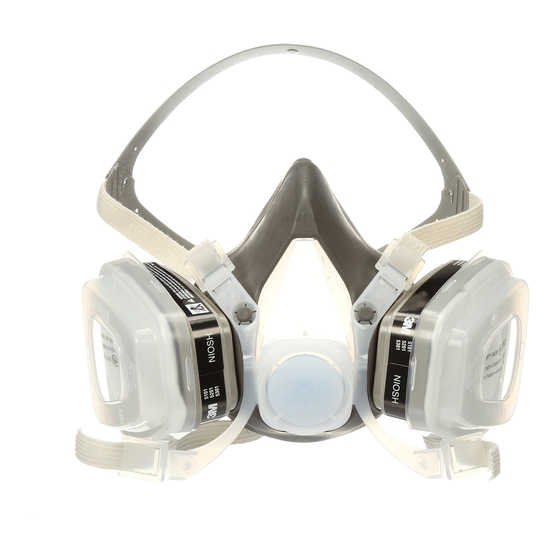
K– The Occupational Safety and Health Administration
regulations require gas-proof goggles to be worn with this
respirator when used against formaldehyde.
L– Follow the manufacturer's User's Instructions for
changing cartridges, canister and/or filters. M– All approved
respirators shall be selected, fitted,
used, and maintained in accordance with MSHA,
OSHA, and other applicable regulations.
N– Never substitute, modify, add, or omit parts. Use
only exact replacement parts in the configuration as specified by
the manufacturer.
O– Refer to User's Instructions, and/or maintenance
manuals for information on use and maintenance
of these respirators.
P– NIOSH does not evaluate respirators for use as
surgical masks.
Respirator Assembly Selection and Approvals Before using these
products, the user must read the specific use for, use limitations and
warning information in the User Instructions and product packaging.
Cleaning and Storage Instructions
1.
Clean facepiece after each use (excluding filters and cartridges), with
3M™ 504 Respirator Wipes (or equivalent).
2.
Air dry in a non-contaminated atmosphere.
3.
Respirator components should be inspected prior to each use. A
respirator with any damaged or deteriorated components should be
discarded.
4.
The cleaned respirator should be stored in the bag, away from
contaminated areas when not in use.
Service Life of Respirator Assemblies
3M™ 5000 Series Respirators should be used before the expiration date
on respirator packaging. The useful service life of these respirators will
depend upon the activity of the wearer (breathing rate), specific type,
volatility and concentration of contaminants and environmental conditions
such as humidity, pressure, and temperature. Respirators
must be replaced in accordance with an established change schedule, or
replace earlier if smell, taste or irritation from the contaminant is
detected.
Caution
Failure to properly dispose of spent respirators contaminated by
hazardous materials can result in environmental harm. Handling,
transportation and disposal of spent cartridges, filters, or respirators
must comply with all applicable federal, state, and local laws and
regulations.
FITTING INSTRUCTIONS
Must be followed each time respirator is worn. Filter Assembly
Instructions
1.
Place the 3M™ 5P71 (07194) Filter into the 3M™ 501 (07054) Filter
Retainer so the printed side of the filter faces the cartridge. Diagram 1.
2.
Press the 501 (07054) filter retainer onto the cartridge. It should lock
securely to the cartridge. The 5P71 (07194) filter must completely cover
the face of the cartridge. Diagram 2.
3.
To replace the 5P71 (07194) filter, remove the 501 (07054) filter
retainer by lifting on the tab as shown. Diagram 3.
NOTE: Use of the 501 (07054) filter retainer may aid respirator wearer in
conducting a negative pressure user seal check.
FITTING INSTRUCTIONS
Must be followed each time respirator is worn.
Donning Respirator
1.
Place the respirator over the mouth and nose, then pull the head
harness over the crown of the head. Diagram 4.
2.
Take the bottom straps in both hands, place them in back of the
neck, and hook them together. Diagram 5.
3.
Position the facepiece low on the bridge of your nose for optimal
visibility and the best possible fit. Diagram 6.
4.
Adjust top straps first, then the lower neck straps by pulling on the
ends. DO NOT pull too tight!
(Strap tension may be decreased by pushing out on back side of
buckles).
5.
Perform a positive pressure and/or negative pressure user seal
check. The positive pressure method is recommended. (See
instructions below)
INSTRUCTIONS FOR POSITIVE AND NEGATIVE PRESSURE
USER SEAL CHECKS
•
Do not use with beards or other facial hair or other conditions
that prevent direct contact between the face and the faceseal
of the respirator.
Positive Pressure User Seal Check
Place the palm of your hand over the exhalation valve cover and exhale
gently, see Diagram 7. If the facepiece bulges slightly and no air leaks
are detected between your face and the faceseal, a proper fit has been
obtained. If faceseal air leakage is detected, reposition the respirator
on your face and/or readjust the tension of the elastic straps to
eliminate the leakage. Repeat the above steps. If you cannot achieve
a proper fit, do not enter the contaminated area. See your
supervisor. Negative Pressure User Seal Check
Place the palms of the hands to cover the face of the cartridge or open
area of the 501 filter retainer, when the retainer is attached to the
cartridge, to restrict airflow, see Diagram 8. Inhale gently. If you feel
the facepiece collapse slightly and pull closer to your face with no
leaks between the face
and the faceseal, a proper fit has been obtained. If faceseal air
leakage is detected, reposition the respirator on the face and/or
readjust the tension of the elastic straps to eliminate the air
leakage.
Repeat the above steps. If you cannot achieve a proper fit, do not
enter the contaminated area. See your supervisor.
Note: Before assigning any respirator to be worn in a
contaminated area, a qualitative or quantitative fit test must be
performed per OSHA Standard 1910.134 or CSA Standard Z94.4.
FIT TESTING
The effectiveness of a respirator will be reduced if it is not fitted
properly. Therefore, either quantitative or qualitative fit testing must
be conducted prior to the respirator being issued. Note: Fit testing is
a U.S. Occupational Safety and Health Administration (OSHA) and
Canadian CSA requirement.
QUANTITATIVE FIT TESTING
Quantitative Fit Testing (QNFT) can be conducted using a 3M™
6000 Series Quantitative Fit Test Respirator Assembly.
QUALITATIVE FIT TESTING
Qualitative Fit Testing (QLFT) with the 3M™ FT-10 or FT-30
Qualitative Fit Test Apparatus can be conducted using the 3M™
5000 Series Respirator Assembly equipped with 3M™ 5P71
Particulate filters and 3M™ 501 Retainers.
Respirators should be fit tested while wearing the personal protective
equipment (PPE) the wearer may use in their work environment that
may affect the fit of the respirator (e.g. hoods, hardhats, safety
glasses, hearing protections, etc.).
Check out an excellent selection of masks & respirators we offer on our website.
